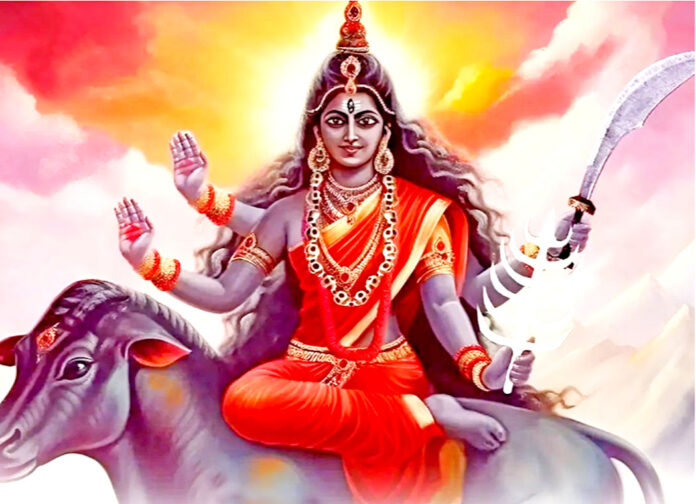On the seventh day of Navaratri, devotees pay homage to Maa Kaalratri, a formidable and awe-inspiring form of the Goddess. The name “Kaalratri” is derived from “kaal,” meaning time or death, and “ratri,” which translates to night or darkness. Thus, Kaalratri embodies the force that dispels darkness, symbolizing the emergence of light and wisdom. Often referred to as “Kaali,” her name emphasizes her powerful and fierce nature.
The Formidable Presence of Maa Kaalratri
Maa Kaalratri is recognized as one of the most fearsome manifestations of the Goddess. Her dark complexion represents her intense and unyielding nature, serving as a reminder of her power to vanquish ignorance and negativity. She is typically depicted with four arms: two holding a kripan (scimitar) and a vajra (thunderbolt), while the other two are positioned in the mudras of giving and protection. Her three eyes, which see all, pierce through the darkness, symbolizing her omniscience.
Flames emanate from her nostrils as she breathes, embodying her unwavering determination and ferocity. This image of fire represents her ability to consume negativity and fear, reinforcing her role as a protective force. Maa Kaalratri’s necklace shines like the moonlight in the night sky, while her hair flows freely, illustrating her wild and untamed spirit. Interestingly, she chooses to ride a donkey, a unique aspect that emphasizes her individuality and defiance of norms.
Despite her fierce appearance, Maa Kaalratri is a kind goddess who bestows auspicious blessings upon her devoted worshippers. Her various names, such as “Bhayakarini” (the eliminator of fear) and “Shubhankari” (the performer of good deeds), underscore the dual nature of her character. This duality suggests that even in the darkest moments, a glimmer of hope and prosperity remains, embodying the belief that light can emerge from darkness.
Rituals and Worship of Maa Kaalratri
The worship of Maa Kaalratri involves unique evening rituals that hold significant meaning. During these rituals, the goddess is placed on a red blanket, symbolizing her fierce yet benevolent nature. Devotees begin by sanctifying the sacred space with Ganga water, creating an environment conducive to spiritual connection. Under the soft glow of a ghee lamp, family members gather to sing bhajans and strotras, inviting the divine presence of Maa Kaalratri into their homes.
As part of the ritual, devotees offer Roli (red powder), Akshat (uncooked rice), and fragrant Ratrani flowers along with jaggery. The Aarti, a ceremonial lighting of a camphor or lamp accompanied by chants and bhajans, follows, marking a climactic moment in the worship. To deepen their spiritual experience, devotees recite the Durga Chalisa or Durga Saptashati and chant Maa Durga’s mantras. The use of red sandalwood or Rudraksha malas for mantra recitation further enhances the connection to the divine.
The Epic Tale of Maa Kaalratri
The origin story of Maa Kaalratri is a thrilling narrative filled with bravery and divine intervention. It begins when the asuras Shumbha and Nishumbha launched an attack on Devlok, defeating Indra and his celestial companions. In desperation, Indra sought help from Maa Parvati, who, in turn, created the mighty Chandi to aid the devatas.
However, Shumbha and Nishumbha did not back down easily. They sent Chanda and Munda to confront Chandi, yet she was not alone in her fight. Chandi summoned the fierce and fearless Maa Kaalratri, who rose to the occasion with unwavering determination. Kaalratri engaged in a fierce battle, eliminating Chanda and Munda. However, the confrontation was just beginning.
Enter Raktabeej, a powerful asura endowed with a formidable boon: each time a drop of his blood touched the ground, he would regenerate.
This boon presented a monumental challenge to Kaalratri, but she was not one to back down from a fight. Fueled by her anger and determination, she resolved to end Raktabeej’s reign of terror once and for all.
Maa Kaalratri showcased her unmatched strength and unwavering courage. She ingeniously devised a strategy to devour every drop of Raktabeej’s blood before it could touch the ground, ultimately leading to his defeat. With Raktabeej eliminated, Chandi was able to defeat Shumbha and Nishumbha, restoring peace and harmony to Devlok.
This epic tale of bravery and divine intervention stands as a testament to the indomitable spirit of Maa Kaalratri. She fearlessly protected the heavens and ensured the triumph of good over evil, illustrating the significance of her role within the divine narrative.
The Symbolism of Maa Kaalratri
Maa Kaalratri’s essence is a powerful reminder of the duality inherent in life. While she embodies fearlessness and ferocity, she also represents kindness and compassion for her devotees. Her dark complexion and fearsome appearance serve to dispel ignorance and fear, illuminating the path toward enlightenment and wisdom.
In the face of adversity, Maa Kaalratri inspires her devotees to be courageous and resilient. She symbolizes the strength that lies in overcoming challenges and the light that can emerge from the depths of darkness. As such, her worship during Navaratri serves not only as a celebration of her power but also as an affirmation of the potential for transformation within every individual. As devotees honor Maa Kaalratri during the seventh day of Navaratri, they engage in rituals that embody reverence for her fierce yet benevolent nature. The story of her courage and divine intervention against the forces of evil serves as a reminder of the importance of resilience, bravery, and the pursuit of truth. In a world often overshadowed by darkness and uncertainty, Maa Kaalratri stands as a beacon of hope and strength, encouraging her devotees to rise against adversity and seek the light that follows the night.






























